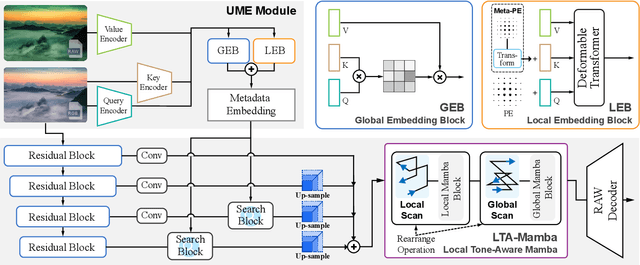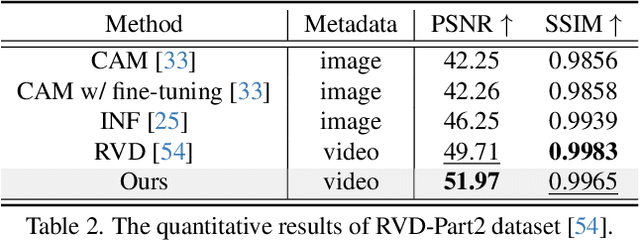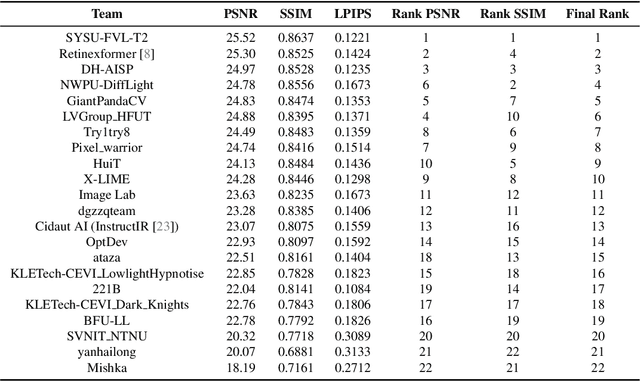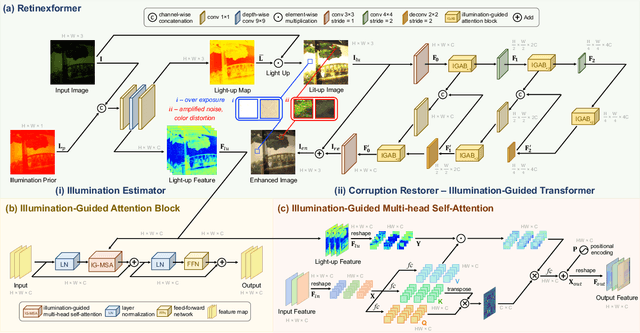Huan Zheng
The Tenth NTIRE 2025 Efficient Super-Resolution Challenge Report
Apr 14, 2025Abstract:This paper presents a comprehensive review of the NTIRE 2025 Challenge on Single-Image Efficient Super-Resolution (ESR). The challenge aimed to advance the development of deep models that optimize key computational metrics, i.e., runtime, parameters, and FLOPs, while achieving a PSNR of at least 26.90 dB on the $\operatorname{DIV2K\_LSDIR\_valid}$ dataset and 26.99 dB on the $\operatorname{DIV2K\_LSDIR\_test}$ dataset. A robust participation saw \textbf{244} registered entrants, with \textbf{43} teams submitting valid entries. This report meticulously analyzes these methods and results, emphasizing groundbreaking advancements in state-of-the-art single-image ESR techniques. The analysis highlights innovative approaches and establishes benchmarks for future research in the field.
CubeFormer: A Simple yet Effective Baseline for Lightweight Image Super-Resolution
Dec 03, 2024Abstract:Lightweight image super-resolution (SR) methods aim at increasing the resolution and restoring the details of an image using a lightweight neural network. However, current lightweight SR methods still suffer from inferior performance and unpleasant details. Our analysis reveals that these methods are hindered by constrained feature diversity, which adversely impacts feature representation and detail recovery. To respond this issue, we propose a simple yet effective baseline called CubeFormer, designed to enhance feature richness by completing holistic information aggregation. To be specific, we introduce cube attention, which expands 2D attention to 3D space, facilitating exhaustive information interactions, further encouraging comprehensive information extraction and promoting feature variety. In addition, we inject block and grid sampling strategies to construct intra-cube transformer blocks (Intra-CTB) and inter-cube transformer blocks (Inter-CTB), which perform local and global modeling, respectively. Extensive experiments show that our CubeFormer achieves state-of-the-art performance on commonly used SR benchmarks. Our source code and models will be publicly available.
RAWMamba: Unified sRGB-to-RAW De-rendering With State Space Model
Nov 18, 2024



Abstract:Recent advancements in sRGB-to-RAW de-rendering have increasingly emphasized metadata-driven approaches to reconstruct RAW data from sRGB images, supplemented by partial RAW information. In image-based de-rendering, metadata is commonly obtained through sampling, whereas in video tasks, it is typically derived from the initial frame. The distinct metadata requirements necessitate specialized network architectures, leading to architectural incompatibilities that increase deployment complexity. In this paper, we propose RAWMamba, a Mamba-based unified framework developed for sRGB-to-RAW de-rendering across both image and video domains. The core of RAWMamba is the Unified Metadata Embedding (UME) module, which harmonizes diverse metadata types into a unified representation. In detail, a multi-perspective affinity modeling method is proposed to promote the extraction of reference information. In addition, we introduce the Local Tone-Aware Mamba (LTA-Mamba) module, which captures long-range dependencies to enable effective global propagation of metadata. Experimental results demonstrate that the proposed RAWMamba achieves state-of-the-art performance, yielding high-quality RAW data reconstruction.
Decoupling Fine Detail and Global Geometry for Compressed Depth Map Super-Resolution
Nov 05, 2024Abstract:Recovering high-quality depth maps from compressed sources has gained significant attention due to the limitations of consumer-grade depth cameras and the bandwidth restrictions during data transmission. However, current methods still suffer from two challenges. First, bit-depth compression produces a uniform depth representation in regions with subtle variations, hindering the recovery of detailed information. Second, densely distributed random noise reduces the accuracy of estimating the global geometric structure of the scene. To address these challenges, we propose a novel framework, termed geometry-decoupled network (GDNet), for compressed depth map super-resolution that decouples the high-quality depth map reconstruction process by handling global and detailed geometric features separately. To be specific, we propose the fine geometry detail encoder (FGDE), which is designed to aggregate fine geometry details in high-resolution low-level image features while simultaneously enriching them with complementary information from low-resolution context-level image features. In addition, we develop the global geometry encoder (GGE) that aims at suppressing noise and extracting global geometric information effectively via constructing compact feature representation in a low-rank space. We conduct experiments on multiple benchmark datasets, demonstrating that our GDNet significantly outperforms current methods in terms of geometric consistency and detail recovery. In the ECCV 2024 AIM Compressed Depth Upsampling Challenge, our solution won the 1st place award. Our codes will be available.
NTIRE 2024 Challenge on Low Light Image Enhancement: Methods and Results
Apr 22, 2024



Abstract:This paper reviews the NTIRE 2024 low light image enhancement challenge, highlighting the proposed solutions and results. The aim of this challenge is to discover an effective network design or solution capable of generating brighter, clearer, and visually appealing results when dealing with a variety of conditions, including ultra-high resolution (4K and beyond), non-uniform illumination, backlighting, extreme darkness, and night scenes. A notable total of 428 participants registered for the challenge, with 22 teams ultimately making valid submissions. This paper meticulously evaluates the state-of-the-art advancements in enhancing low-light images, reflecting the significant progress and creativity in this field.
GT-Rain Single Image Deraining Challenge Report
Mar 18, 2024


Abstract:This report reviews the results of the GT-Rain challenge on single image deraining at the UG2+ workshop at CVPR 2023. The aim of this competition is to study the rainy weather phenomenon in real world scenarios, provide a novel real world rainy image dataset, and to spark innovative ideas that will further the development of single image deraining methods on real images. Submissions were trained on the GT-Rain dataset and evaluated on an extension of the dataset consisting of 15 additional scenes. Scenes in GT-Rain are comprised of real rainy image and ground truth image captured moments after the rain had stopped. 275 participants were registered in the challenge and 55 competed in the final testing phase.
Diving Deep into Regions: Exploiting Regional Information Transformer for Single Image Deraining
Feb 25, 2024Abstract:Transformer-based Single Image Deraining (SID) methods have achieved remarkable success, primarily attributed to their robust capability in capturing long-range interactions. However, we've noticed that current methods handle rain-affected and unaffected regions concurrently, overlooking the disparities between these areas, resulting in confusion between rain streaks and background parts, and inabilities to obtain effective interactions, ultimately resulting in suboptimal deraining outcomes. To address the above issue, we introduce the Region Transformer (Regformer), a novel SID method that underlines the importance of independently processing rain-affected and unaffected regions while considering their combined impact for high-quality image reconstruction. The crux of our method is the innovative Region Transformer Block (RTB), which integrates a Region Masked Attention (RMA) mechanism and a Mixed Gate Forward Block (MGFB). Our RTB is used for attention selection of rain-affected and unaffected regions and local modeling of mixed scales. The RMA generates attention maps tailored to these two regions and their interactions, enabling our model to capture comprehensive features essential for rain removal. To better recover high-frequency textures and capture more local details, we develop the MGFB as a compensation module to complete local mixed scale modeling. Extensive experiments demonstrate that our model reaches state-of-the-art performance, significantly improving the image deraining quality. Our code and trained models are publicly available.
Leveraging Herpangina Data to Enhance Hospital-level Prediction of Hand-Foot-and-Mouth Disease Admissions Using UPTST
Sep 26, 2023Abstract:Outbreaks of hand-foot-and-mouth disease(HFMD) have been associated with significant morbidity and, in severe cases, mortality. Accurate forecasting of daily admissions of pediatric HFMD patients is therefore crucial for aiding the hospital in preparing for potential outbreaks and mitigating nosocomial transmissions. To address this pressing need, we propose a novel transformer-based model with a U-net shape, utilizing the patching strategy and the joint prediction strategy that capitalizes on insights from herpangina, a disease closely correlated with HFMD. This model also integrates representation learning by introducing reconstruction loss as an auxiliary loss. The results show that our U-net Patching Time Series Transformer (UPTST) model outperforms existing approaches in both long- and short-arm prediction accuracy of HFMD at hospital-level. Furthermore, the exploratory extension experiments show that the model's capabilities extend beyond prediction of infectious disease, suggesting broader applicability in various domains.
Decoupled Cross-Scale Cross-View Interaction for Stereo Image Enhancement in The Dark
Nov 12, 2022Abstract:Low-light stereo image enhancement (LLSIE) is a relatively new task to enhance the quality of visually unpleasant stereo images captured in dark condition. However, current methods achieve inferior performance on detail recovery and illumination adjustment. We find it is because: 1) the insufficient single-scale inter-view interaction makes the cross-view cues unable to be fully exploited; 2) lacking long-range dependency leads to the inability to deal with the spatial long-range effects caused by illumination degradation. To alleviate such limitations, we propose a LLSIE model termed Decoupled Cross-scale Cross-view Interaction Network (DCI-Net). Specifically, we present a decoupled interaction module (DIM) that aims for sufficient dual-view information interaction. DIM decouples the dual-view information exchange into discovering multi-scale cross-view correlations and further exploring cross-scale information flow. Besides, we present a spatial-channel information mining block (SIMB) for intra-view feature extraction, and the benefits are twofold. One is the long-range dependency capture to build spatial long-range relationship, and the other is expanded channel information refinement that enhances information flow in channel dimension. Extensive experiments on Flickr1024, KITTI 2012, KITTI 2015 and Middlebury datasets show that our method obtains better illumination adjustment and detail recovery, and achieves SOTA performance compared to other related methods. Our codes, datasets and models will be publicly available.
 Add to Chrome
Add to Chrome Add to Firefox
Add to Firefox Add to Edge
Add to Edge